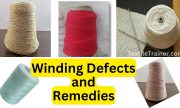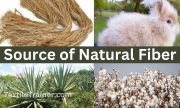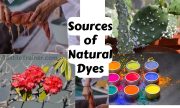Oils, waxes, and fats are all types of lipids, which are organic compounds that are insoluble in water but soluble in organic solvents such as ether, chloroform, and benzene. These compounds are present in different fibers and play important roles in their properties and characteristics.

Chemistry & properties of Oils
Here are some general characteristics of the oils present in different fibers:
Oil in cotton fiber
Cotton fibers contain a small amount of natural oil that is composed of fatty acids, glycerides, and other lipids. These oils contribute to the strength, flexibility, and water resistance of the fibers. Cottonseed oil, which is derived from cotton seeds, is used in a variety of industrial and food applications due to its high level of unsaturated fatty acids and antioxidants.
Oil in wool fiber
Wool fibers contain natural oil that is secreted by the sebaceous glands of sheep. These oils contribute to the softness, flexibility, and water resistance of the fibers. Wool oil is also used in various industrial and cosmetic applications due to its emollient and moisturizing properties.
Oil in silk fiber
Silk fibers also contain natural oil, which is composed of a mixture of fatty acids, phospholipids, and cholesterol. These oils contribute to the strength, flexibility, and water resistance of the fibers. Silk oil is also used in various cosmetic and medicinal applications due to its anti-inflammatory and wound-healing properties.
Oil in synthetic fiber
Synthetic fibers, such as polyester and nylon, do not contain natural oils. However, they can be treated with various chemicals to impart specific properties, such as lubrication, water resistance, or antistatic properties.
Overall, the chemistry and properties of oils present in different fibers play an important role in determining the characteristics and performance of the fibers. Understanding the composition and behavior of these oils is important for developing new fibers with improved properties and applications.
Chemistry & properties of Waxes
Here are some general characteristics of the waxes present in different fibers:
Wax in cotton fiber
Cotton fibers contain a small amount of natural wax that gives them a slightly glossy appearance and provides some protection against water and other liquids. The wax is composed of fatty acids, alcohols, and hydrocarbons, and its composition can vary depending on the specific variety of cotton. The wax helps to protect the fibers from moisture and also helps to reduce friction between the fibers during processing.
Wax in wool fiber
Wool fibers also contain natural wax, which is secreted by the sebaceous glands of sheep. The wax helps to lubricate the fibers and prevent them from becoming brittle and breaking. The main component of wool wax is lanolin, which is a complex mixture of esters, fatty acids, and alcohols. Lanolin is also used in various cosmetic and medicinal applications due to its emollient and moisturizing properties.
Wax in silk fiber
Silk fibers contain a complex mixture of proteins and lipids, including waxes such as ceramides and cholesterol esters. These waxes play a critical role in the structure and properties of silk fibers, helping to provide strength, flexibility, and water resistance.
In general, the waxes present in different fibers play an important role in determining their properties and characteristics. They contribute to the water resistance, lubrication, and durability of the fibers, and also play a role in the processing and manufacturing of textile products. Understanding the chemistry and properties of these waxes is important for developing new fibers and improving the performance of existing ones.
Chemistry & properties of Fats
Here are some general characteristics of the fats that can be present in different fibers:
Fat in cotton fiber
Cotton fibers contain a small amount of natural fats that are composed of glycerides and fatty acids. These fats contribute to the strength and durability of the fibers, and also play a role in the processing and manufacturing of textile products.
Fat in wool fiber
Wool fibers also contain natural fats, which are composed of a mixture of glycerides, fatty acids, and sterols. These fats help to lubricate the fibers and prevent them from becoming brittle and breaking. They also contribute to the softness and flexibility of the fibers.
Fat in silk fiber
Silk fibers contain a complex mixture of proteins and lipids, including fats such as glycerides, fatty acids, and sterols. These fats play a critical role in the structure and properties of silk fibers, helping to provide strength, flexibility, and water resistance.
In general, the fats present in different fibers contribute to their strength, durability, and flexibility, and play a role in the processing and manufacturing of textile products. While their presence may be less common than oils and waxes, they still play an important role in determining the properties and characteristics of the fibers. Understanding the chemistry and properties of these fats is important for developing new fibers and improving the performance of existing ones.







Thanks again for the article post.Much thanks again. Cool.
please stay with us.
Thanks so much for the blog. Cool.
keep visit our site….
I am so grateful for your blog.Much thanks again. Keep writing.
keep visit our site….
A big thank you for your blog post. Much obliged.
thanks too…..please support us.
Wow, great post.Much thanks again. Cool.
Keep visit our site….
Thanks for the blog post.Thanks Again. Really Cool.
keep visit our site….
I think this is a real great article.Really thank you! Really Cool.
thanks…….
Really informative article.Much thanks again. Great.
thanks too. please support us.
Major thankies for the blog post.Really looking forward to read more. Keep writing.
keep visit our site..
Major thankies for the article.Much thanks again. Want more.
ok, we will try.
Thank you for your article post.Really thank you! Keep writing.
Thanks again for the article.Really thank you! Really Cool.
Welcome
Never give up on your dreams. Once you start to follow your path to your dream life, your confidence will rise, and youll enjoy the excitement
Im obliged for the blog.Thanks Again. Want more.
This is one awesome blog article.Much thanks again. Awesome.
I loved your article post.Really thank you! Want more.
I really liked your blog post. Want more.
Looking forward to reading more. Great post.Really thank you! Great.
Im obliged for the blog article.Really thank you! Much obliged.
keep visit our site.
Fantastic blog article.Thanks Again. Will read on…
keep visit our site.
I really like and appreciate your article post.Much thanks again. Keep writing.
keep visit our site.
I value the blog post.Really looking forward to read more.
Thank you for your post.Thanks Again. Great.
Very good post.Really thank you! Really Cool.
thank you too…
Very informative blog.Thanks Again. Much obliged.
Thanks too
Appreciate you sharing, great post.Really looking forward to read more. Really Great.
Thanks again for the post. Much obliged.
Appreciate you sharing, great blog article. Much obliged.
I value the blog.Thanks Again. Much obliged.
Really appreciate you sharing this post.Really looking forward to read more. Great.
I really enjoy the article. Fantastic.
Thank you ever so for you post.Thanks Again. Fantastic.
I truly appreciate this post.Really thank you! Awesome.
Thanks a lot for the article post.Really thank you!
I really like and appreciate your article post. Will read on…
wow, awesome blog article.Much thanks again.
Thank you ever so for you blog post.Really thank you! Keep writing.
Really appreciate you sharing this post. Fantastic.
I really liked your article.Thanks Again. Cool.
I am so grateful for your blog article.Much thanks again. Want more.
Hey, thanks for the article. Fantastic.
I value the article.Really looking forward to read more. Really Cool.
Appreciate you sharing, great blog article.Thanks Again.
Thanks again for the blog.Really thank you! Really Great.
Major thankies for the post. Cool.
I think this is a real great article post. Cool.
Say, you got a nice blog post.Really thank you! Keep writing.
I value the blog. Cool.
Im thankful for the blog. Fantastic.
Thanks for sharing, this is a fantastic blog.Really thank you! Keep writing.
This is one awesome post.Really thank you! Keep writing.
Major thanks for the article.Thanks Again. Really Great.
Thank you for your article post.Really thank you! Awesome.
Im thankful for the article post.Really looking forward to read more. Cool.
Thanks a lot for the blog.Much thanks again. Really Great.
Major thanks for the article post.Really looking forward to read more. Fantastic.
I loved your article post.Thanks Again. Much obliged.
wow, awesome blog article.Much thanks again. Will read on…
Really informative blog. Much obliged.
Major thanks for the post.Really thank you! Fantastic.
Awesome post.Much thanks again. Keep writing.
Thank you for your blog article.Thanks Again.
I value the article post.Really thank you! Want more.
I truly appreciate this article.Really thank you! Cool.
I really enjoy the post. Really Great.
A round of applause for your blog post.Really thank you!
Wow, great blog.Much thanks again. Keep writing.
I really like and appreciate your blog post.Much thanks again.
Im thankful for the article post.Really thank you! Want more.
Really appreciate you sharing this article.Thanks Again. Awesome.
Fantastic article.Thanks Again. Cool.
Very neat article.Much thanks again. Fantastic.
wow, awesome article.Really thank you! Fantastic.
I truly appreciate this article post.Thanks Again. Want more.
Major thankies for the blog.Really thank you! Will read on…
I really liked your blog article.Thanks Again. Really Cool.
Very informative blog post.Really looking forward to read more. Great.
wow, awesome article post.Thanks Again. Fantastic.
Really appreciate you sharing this article.Much thanks again. Awesome.
I am so grateful for your article.Thanks Again. Great.
Very neat post.Really looking forward to read more. Really Great.
Major thanks for the blog post.
Wow, great blog article.Really thank you!
I really enjoy the post.Much thanks again. Awesome.
Thanks again for the blog. Really Great.
Great, thanks for sharing this article. Keep writing.
Wow, great blog post.Really thank you! Want more.
I really enjoy the article. Really Cool.
I really liked your blog article.Much thanks again. Keep writing.
I really liked your article. Keep writing.
Thanks again for the blog.Thanks Again.
Really informative article. Fantastic.
Appreciate you sharing, great post.Really thank you! Much obliged.
Very neat article. Cool.
Thank you for your blog post.Really thank you! Really Great.
Very good post.Much thanks again. Will read on…
Thanks
Im obliged for the article.Thanks Again. Want more.
Hey, thanks for the article. Keep writing.
A big thank you for your post.Thanks Again. Want more.
Thanks too
I really liked your blog. Really Great.
Wow, great article post.Really thank you! Keep writing.
Thanks for sharing, this is a fantastic blog article.Really thank you! Much obliged.
Thank you ever so for you article.Thanks Again.
Very good blog.Really thank you! Keep writing.
I really enjoy the post.Thanks Again. Fantastic.
Hey, thanks for the article.Really looking forward to read more. Fantastic.
This is one awesome article post.Thanks Again. Want more.
I really liked your article.Much thanks again. Really Cool.
Say, you got a nice article. Awesome.
Looking forward to reading more. Great blog article.Really looking forward to read more. Cool.
Awesome blog.Thanks Again. Great.
I really enjoy the blog post. Want more.
I appreciate you sharing this article.Really thank you! Will read on…
Appreciate you sharing, great blog post.Thanks Again. Really Cool.
Awesome blog.Really looking forward to read more. Want more.
Really enjoyed this post.Much thanks again. Really Great.
Really enjoyed this blog post.Much thanks again. Fantastic.
I am so grateful for your article post.Really thank you! Awesome.
Thanks for sharing, this is a fantastic blog article.Really thank you! Really Cool.
Very informative article. Awesome.
wow, awesome post. Awesome.